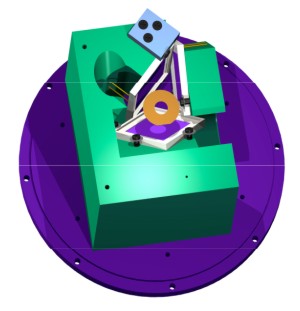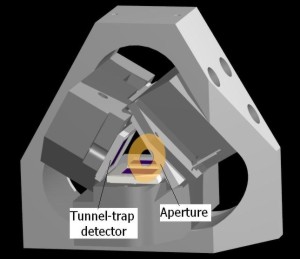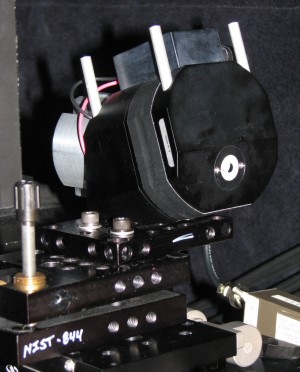Transfer and working standard radiometers and photometers
 Reflectance-type silicon trap-detectors – Silicon trap-detectors have been developed for use as transfer standards for the IR-SIRCUS and IR-Laser Scatter and Detector Characterization facilities. They are built using either Hamamatsu S6337 or S1337 photodiodes. UV silicon trap-detectors have also been developed. They are built using UV damage resistant IRD UVG-100 silicon photodiodes, selected for high and equal shunt resistance.
Reflectance-type silicon trap-detectors – Silicon trap-detectors have been developed for use as transfer standards for the IR-SIRCUS and IR-Laser Scatter and Detector Characterization facilities. They are built using either Hamamatsu S6337 or S1337 photodiodes. UV silicon trap-detectors have also been developed. They are built using UV damage resistant IRD UVG-100 silicon photodiodes, selected for high and equal shunt resistance.
 Silicon tunnel-trap detectors – A group of six silicon tunnel-trap detectors have been developed to maintain the lowest uncertainty (reference) spectral power and irradiance responsivity scales between 300 nm and 950 nm. The group consists of two medium size (10 mm by 10 mm) Hamamatsu 1337 and four large size (18 mm by 18 mm) Hamamatsu 6337 silicon photodiodes connected in parallel.
Silicon tunnel-trap detectors – A group of six silicon tunnel-trap detectors have been developed to maintain the lowest uncertainty (reference) spectral power and irradiance responsivity scales between 300 nm and 950 nm. The group consists of two medium size (10 mm by 10 mm) Hamamatsu 1337 and four large size (18 mm by 18 mm) Hamamatsu 6337 silicon photodiodes connected in parallel.
Filter trap-radiometers – Tunnel-trap detector-based filter radiometers have been designed to make radiance and irradiance measurements for use in remote sensing applications.
 Sphere-input InGaAs and extended InGaAs detectors – A near-IR radiometer standard with similar performance to silicon trap-detectors has been developed to calibrate detectors and radiometers for absolute spectral power, irradiance, and radiance responsivities between 950 nm and 1650 nm. It is used at SIRCUS which is the NIST reference calibration facility for absolute responsivity. The power-to-irradiance scale conversion uncertainty is 0.05% (k=2). An extended-InGaAs detector has also been developed to obtain radiant power to irradiance mode converters to 2.5 µm. It is constructed with Spectralon coated 5 cm diameter integrating spheres equipped with 5 mm diameter input apertures mounted to the front of three extended-InGaAs radiometers. The radiometer converters are calibrated in power mode against the L-1 cryogenic radiometer.
Sphere-input InGaAs and extended InGaAs detectors – A near-IR radiometer standard with similar performance to silicon trap-detectors has been developed to calibrate detectors and radiometers for absolute spectral power, irradiance, and radiance responsivities between 950 nm and 1650 nm. It is used at SIRCUS which is the NIST reference calibration facility for absolute responsivity. The power-to-irradiance scale conversion uncertainty is 0.05% (k=2). An extended-InGaAs detector has also been developed to obtain radiant power to irradiance mode converters to 2.5 µm. It is constructed with Spectralon coated 5 cm diameter integrating spheres equipped with 5 mm diameter input apertures mounted to the front of three extended-InGaAs radiometers. The radiometer converters are calibrated in power mode against the L-1 cryogenic radiometer.
Reference photometers – A new reference photometer has been developed to decrease the uncertainty of the detector-based photometric scale published in 1996. The detector is a large-area single-element silicon photodiode closed with a 0.5° window to avoid interference fringes in the output signal of the photodiode. The photopic filters are individually optimized and temperature controlled.
 Pyroelectric radiometers – A LiNbO3 pyroelectric radiometer was developed to extend the NIST reference spectral power responsivity scale from the visible range to the ultraviolet (UV) and infrared (IR). These scales have now been realized with a relative standard uncertainty of less than 0.34 % (coverage factor k=1) between 250 nm and 2.5 µm.
Pyroelectric radiometers – A LiNbO3 pyroelectric radiometer was developed to extend the NIST reference spectral power responsivity scale from the visible range to the ultraviolet (UV) and infrared (IR). These scales have now been realized with a relative standard uncertainty of less than 0.34 % (coverage factor k=1) between 250 nm and 2.5 µm.
New LiTaO3 pyroelectric radiometers were developed to extend the spectral power responsivity scale up to 19 µm. The gold-black coated pyroelectric detectors are temperature controlled using a thermoelectric cooler/heater and a thermistor sensor, and the relative responsivity is determined from spectral reflectance measurements at the FT IR Spectrophotometry Facility when the detector was equipped with a reflecting dome.
For routine, monochromator-based spectral power responsivity scale calibrations in the infrared, a group of newly developed pyroelectric radiometers have been developed with hybrid detector-amplifier packages. Hybrid packages were selected with noise-equivalent powers that are one order of magnitude lower than that of traditional pyroelectric detectors and current-amplifiers. The relative standard uncertainty of these detectors is 1% (k=2).
Visible and near-IR working standards - The NIST-developed first generation Si, Ge, and InGaAs radiometers and photometers, which measure power, irradiance, and radiance, made the transition possible from traditional lamp-based scales to lower uncertainty detector-based scales. A new generation modular radiometer-photometer system has been designed to satisfy the increased measurement and uncertainty requirements. These radiometers can measure DC or AC optical radiation within a dynamic signal range of 14 decades.
 Short-wave IR detectors for radiation thermometers and target simulators - The extended-InGaAs and HgCdTe (MCT) radiometers can measure thermal radiation from ambient-temperature objects using regular glass optics. The achieved detectivity, D*= 4 x 1013 cm Hz1/2/W, is near to background limited noise performance at 295 K. The Noise Equivalent Power (NEP) of the extended-InGaAs radiometers at 9 Hz chopping frequency was decreased to 5.4 fW. Thermal imagers built with these short-wave IR devices can have better imaging performance and lower NETD than existing, cryogenically-cooled thermal imagers. Infrared collimators were calibrated using an extended-InGaAs radiometer with 100 times higher irradiance sensitivity than InSb irradiance meters.
Short-wave IR detectors for radiation thermometers and target simulators - The extended-InGaAs and HgCdTe (MCT) radiometers can measure thermal radiation from ambient-temperature objects using regular glass optics. The achieved detectivity, D*= 4 x 1013 cm Hz1/2/W, is near to background limited noise performance at 295 K. The Noise Equivalent Power (NEP) of the extended-InGaAs radiometers at 9 Hz chopping frequency was decreased to 5.4 fW. Thermal imagers built with these short-wave IR devices can have better imaging performance and lower NETD than existing, cryogenically-cooled thermal imagers. Infrared collimators were calibrated using an extended-InGaAs radiometer with 100 times higher irradiance sensitivity than InSb irradiance meters.
Mid- and long-wave IR working standards - Infrared radiometer standards have also been developed for the 2 μm to 5 μm and the 8 μm to 14 μm wavelength ranges.
Major Accomplishments:
- The silicon tunnel-trap reference detector development made it possible to achieve 0.05 % (k=2) uncertainty in the spectral irradiance responsivity scale which is the reference scale of the SIRCUS facility from 400 nm to 960 nm.
- The sphere-input InGaAs detector development made it possible to achieve an irradiance responsivity uncertainty for the 950 nm to 1650 nm range equal to that of the silicon tunnel-trap detectors. This is the existing lowest-uncertainty reference irradiance-responsivity scale covering the overall visible and near-IR wavelength ranges for the SIRCUS.
- The NIST patented SWIR irradiance measuring radiometers have hundred times lower noise-equivalent-irradiance (< 5 fW/cm2) than background-optimized InSb irradiance meters. They significantly improved the uncertainty of IR target simulator calibrations and are candidate-sensors for different military applications.


 Reflectance-type silicon trap-detectors – Silicon trap-detectors have been developed for use as transfer standards for the IR-SIRCUS and IR-Laser Scatter and Detector Characterization facilities. They are built using either Hamamatsu S6337 or S1337 photodiodes. UV silicon trap-detectors have also been developed. They are built using UV damage resistant IRD UVG-100 silicon photodiodes, selected for high and equal shunt resistance.
Reflectance-type silicon trap-detectors – Silicon trap-detectors have been developed for use as transfer standards for the IR-SIRCUS and IR-Laser Scatter and Detector Characterization facilities. They are built using either Hamamatsu S6337 or S1337 photodiodes. UV silicon trap-detectors have also been developed. They are built using UV damage resistant IRD UVG-100 silicon photodiodes, selected for high and equal shunt resistance. Silicon tunnel-trap detectors – A group of six silicon tunnel-trap detectors have been developed to maintain the lowest uncertainty (reference) spectral power and irradiance responsivity scales between 300 nm and 950 nm. The group consists of two medium size (10 mm by 10 mm) Hamamatsu 1337 and four large size (18 mm by 18 mm) Hamamatsu 6337 silicon photodiodes connected in parallel.
Silicon tunnel-trap detectors – A group of six silicon tunnel-trap detectors have been developed to maintain the lowest uncertainty (reference) spectral power and irradiance responsivity scales between 300 nm and 950 nm. The group consists of two medium size (10 mm by 10 mm) Hamamatsu 1337 and four large size (18 mm by 18 mm) Hamamatsu 6337 silicon photodiodes connected in parallel. Sphere-input InGaAs and extended InGaAs detectors – A near-IR radiometer standard with similar performance to silicon trap-detectors has been developed to calibrate detectors and radiometers for absolute spectral power, irradiance, and radiance responsivities between 950 nm and 1650 nm. It is used at SIRCUS which is the NIST reference calibration facility for absolute responsivity. The power-to-irradiance scale conversion uncertainty is 0.05% (k=2). An extended-InGaAs detector has also been developed to obtain radiant power to irradiance mode converters to 2.5 µm. It is constructed with Spectralon coated 5 cm diameter integrating spheres equipped with 5 mm diameter input apertures mounted to the front of three extended-InGaAs radiometers. The radiometer converters are calibrated in power mode against the L-1 cryogenic radiometer.
Sphere-input InGaAs and extended InGaAs detectors – A near-IR radiometer standard with similar performance to silicon trap-detectors has been developed to calibrate detectors and radiometers for absolute spectral power, irradiance, and radiance responsivities between 950 nm and 1650 nm. It is used at SIRCUS which is the NIST reference calibration facility for absolute responsivity. The power-to-irradiance scale conversion uncertainty is 0.05% (k=2). An extended-InGaAs detector has also been developed to obtain radiant power to irradiance mode converters to 2.5 µm. It is constructed with Spectralon coated 5 cm diameter integrating spheres equipped with 5 mm diameter input apertures mounted to the front of three extended-InGaAs radiometers. The radiometer converters are calibrated in power mode against the L-1 cryogenic radiometer. Pyroelectric radiometers – A LiNbO3 pyroelectric radiometer was developed to extend the NIST reference spectral power responsivity scale from the visible range to the ultraviolet (UV) and infrared (IR). These scales have now been realized with a relative standard uncertainty of less than 0.34 % (coverage factor k=1) between 250 nm and 2.5 µm.
Pyroelectric radiometers – A LiNbO3 pyroelectric radiometer was developed to extend the NIST reference spectral power responsivity scale from the visible range to the ultraviolet (UV) and infrared (IR). These scales have now been realized with a relative standard uncertainty of less than 0.34 % (coverage factor k=1) between 250 nm and 2.5 µm. Short-wave IR detectors for radiation thermometers and target simulators - The extended-InGaAs and HgCdTe (MCT) radiometers can measure thermal radiation from ambient-temperature objects using regular glass optics. The achieved detectivity, D*= 4 x 1013 cm Hz1/2/W, is near to background limited noise performance at 295 K. The Noise Equivalent Power (NEP) of the extended-InGaAs radiometers at 9 Hz chopping frequency was decreased to 5.4 fW. Thermal imagers built with these short-wave IR devices can have better imaging performance and lower NETD than existing, cryogenically-cooled thermal imagers. Infrared collimators were calibrated using an extended-InGaAs radiometer with 100 times higher irradiance sensitivity than InSb irradiance meters.
Short-wave IR detectors for radiation thermometers and target simulators - The extended-InGaAs and HgCdTe (MCT) radiometers can measure thermal radiation from ambient-temperature objects using regular glass optics. The achieved detectivity, D*= 4 x 1013 cm Hz1/2/W, is near to background limited noise performance at 295 K. The Noise Equivalent Power (NEP) of the extended-InGaAs radiometers at 9 Hz chopping frequency was decreased to 5.4 fW. Thermal imagers built with these short-wave IR devices can have better imaging performance and lower NETD than existing, cryogenically-cooled thermal imagers. Infrared collimators were calibrated using an extended-InGaAs radiometer with 100 times higher irradiance sensitivity than InSb irradiance meters.